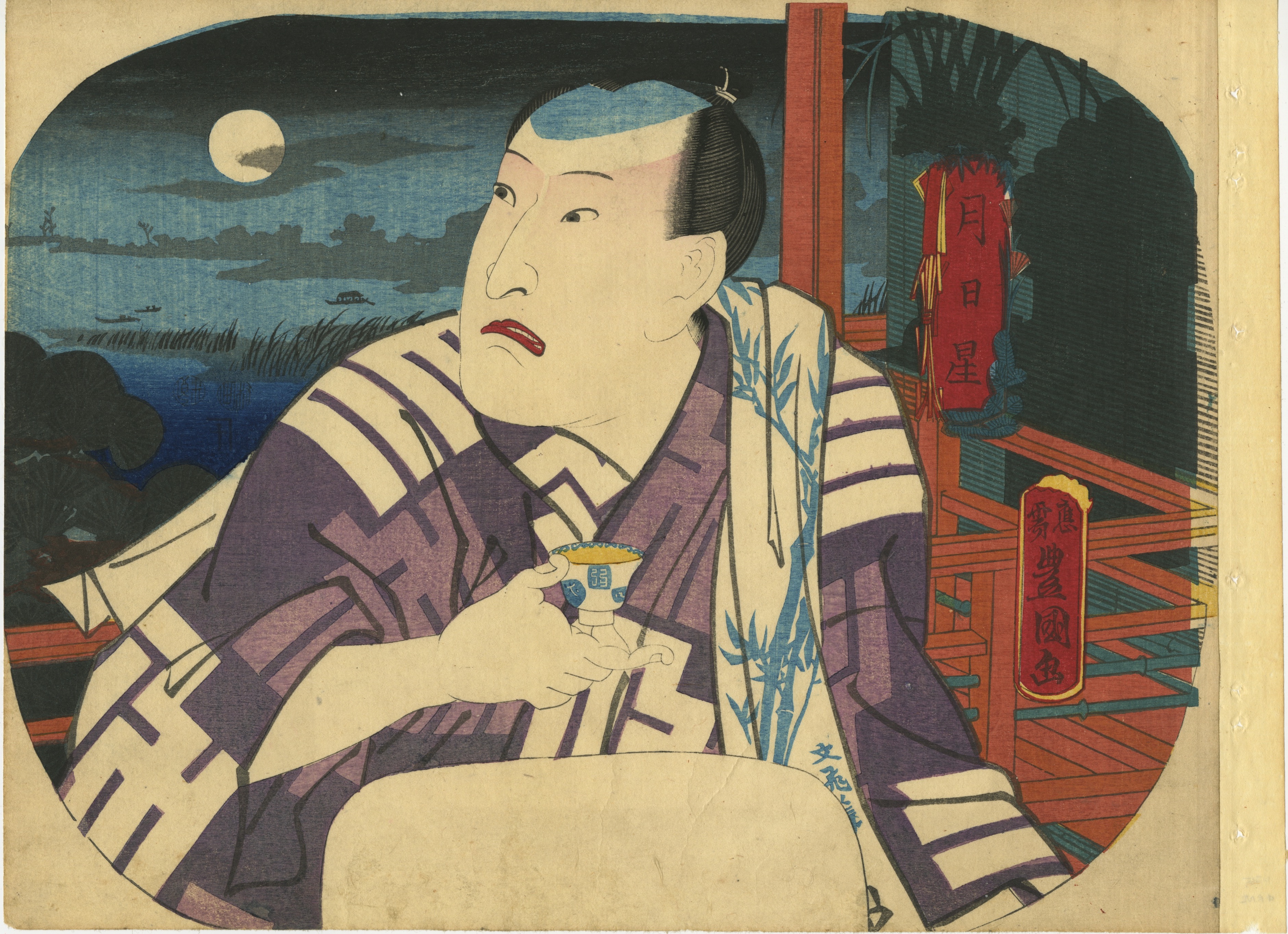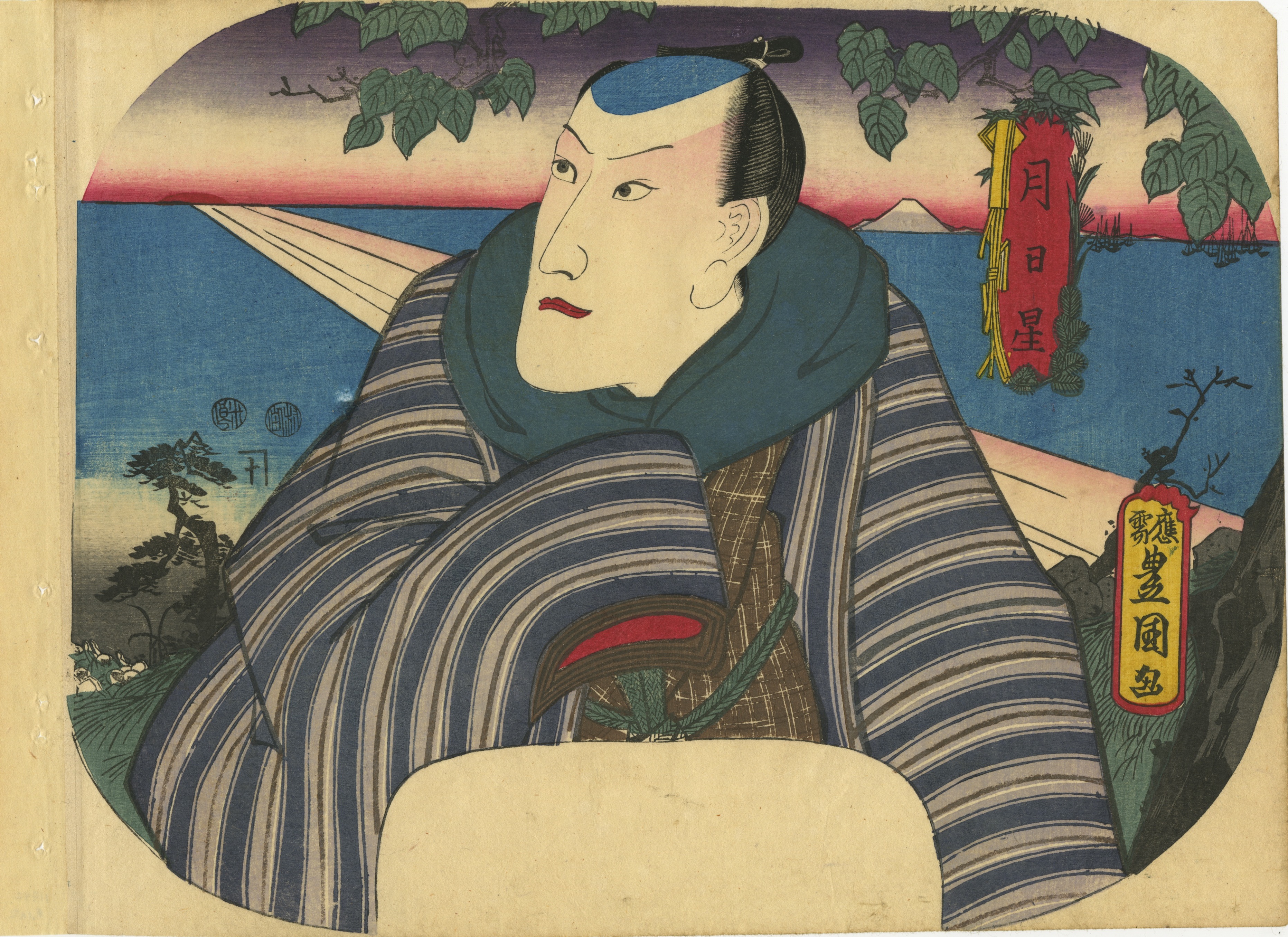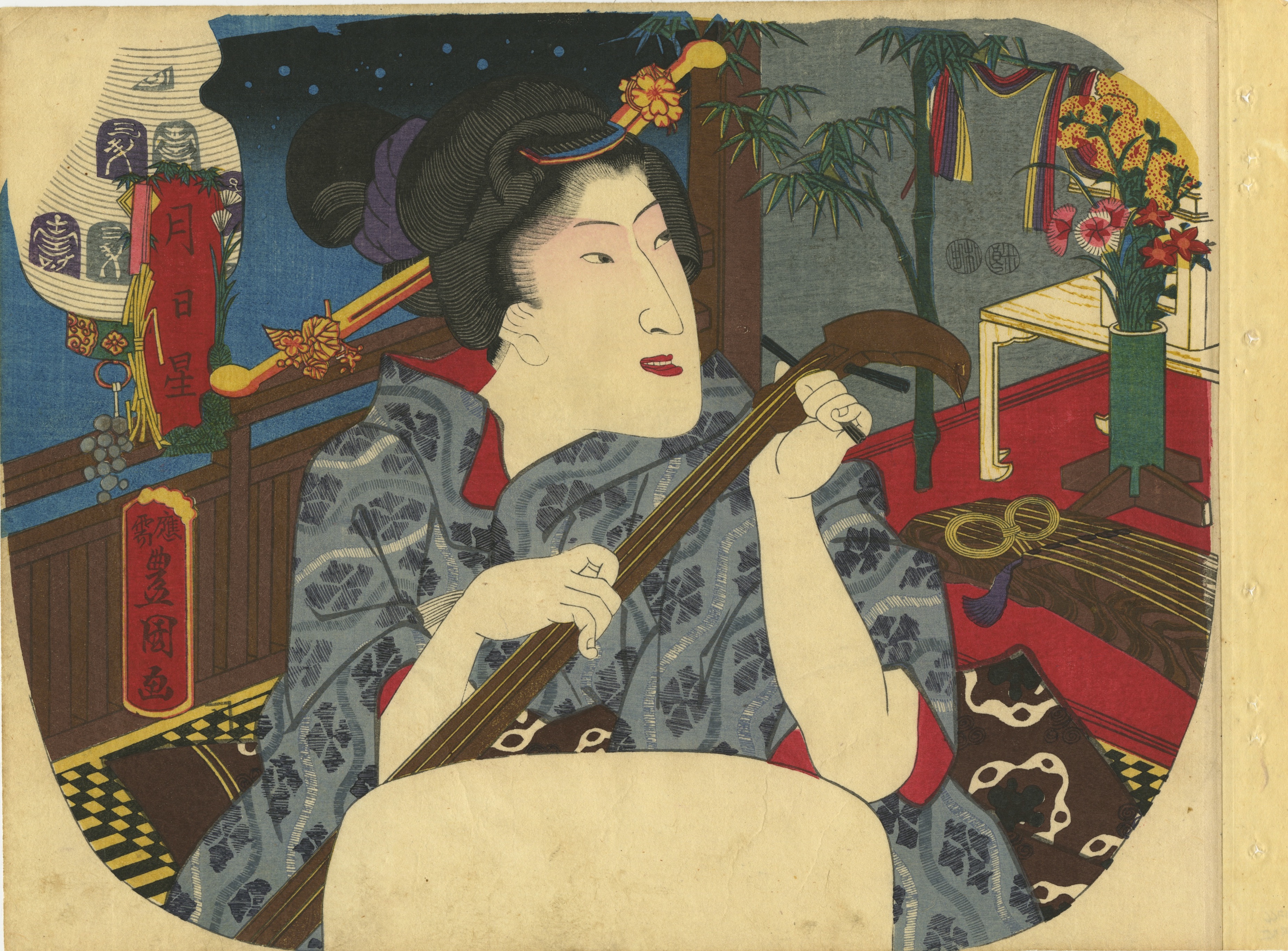-
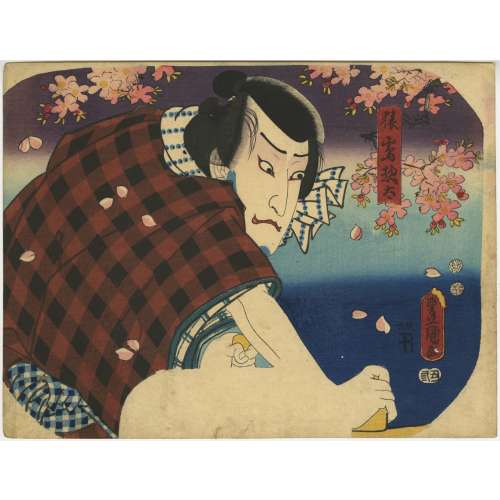 Kabuki actor Arashi Kichisaburō III [嵐吉三郎] as Sarushima Sōta [猿島惣太] in the play Hanamo Yoshida Iwao no Matsuwaka [花吉田岩尾松若] staged at Ichimura-za (市村座), theatre in Edo. Artist: Utagawa Kunisada, a.k.a. Toyokuni III (Japanese, 1786 – 1865) [歌川 国貞]. Publisher: Kojimaya Jūbei (Japanese, 1797-1869), seal: Hanmoto, Jū [板元, 十] (Marks 19-043 | 264c. Date seal and double nanushi censor seals Mera & Watanabe – 3rd month of Kaei 6 (1853). Signed: Toyokuni ga [豊国 画] in a red toshidama cartouche. Media: Fan print (uchiwa-e), 223 x 294 mm. Kabuki actor Arashi Kichisaburō III [嵐吉三郎] (Japanese, 1810 – 1864); other names: Arashi Daizaburō III, Arashi Kitsusaburō III Ref.: Art shop Ezoshi Ukiyoe new collection news, vol. 66, 2023.1 (Jan) # 30, p.8.
Kabuki actor Arashi Kichisaburō III [嵐吉三郎] as Sarushima Sōta [猿島惣太] in the play Hanamo Yoshida Iwao no Matsuwaka [花吉田岩尾松若] staged at Ichimura-za (市村座), theatre in Edo. Artist: Utagawa Kunisada, a.k.a. Toyokuni III (Japanese, 1786 – 1865) [歌川 国貞]. Publisher: Kojimaya Jūbei (Japanese, 1797-1869), seal: Hanmoto, Jū [板元, 十] (Marks 19-043 | 264c. Date seal and double nanushi censor seals Mera & Watanabe – 3rd month of Kaei 6 (1853). Signed: Toyokuni ga [豊国 画] in a red toshidama cartouche. Media: Fan print (uchiwa-e), 223 x 294 mm. Kabuki actor Arashi Kichisaburō III [嵐吉三郎] (Japanese, 1810 – 1864); other names: Arashi Daizaburō III, Arashi Kitsusaburō III Ref.: Art shop Ezoshi Ukiyoe new collection news, vol. 66, 2023.1 (Jan) # 30, p.8. -
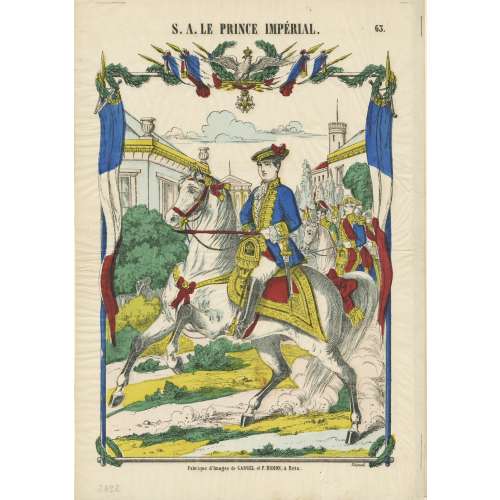 Hand-coloured woodcut on wove paper, 327 x 280 mm; black ink stamp “5265” to reverse, attached to the sheet 470 x 325 mm. Top centre: "S. A. LE PRINCE IMPÉRIAL.", right: "63." Image: equestiral portrait of Prince Impérial. Under the image, centre: "Fabrique d'Images de GANGEL et P. DIDION, à Metz." — "Déposé." Napoléon, Prince Imperial (Napoléon Eugène Louis Jean Joseph Bonaparte] (French, 1856 – 1879). Gangel et P. Didion (Metz); Paulin Didion (French, 1831 – 1879) – publisher/printer.
Hand-coloured woodcut on wove paper, 327 x 280 mm; black ink stamp “5265” to reverse, attached to the sheet 470 x 325 mm. Top centre: "S. A. LE PRINCE IMPÉRIAL.", right: "63." Image: equestiral portrait of Prince Impérial. Under the image, centre: "Fabrique d'Images de GANGEL et P. DIDION, à Metz." — "Déposé." Napoléon, Prince Imperial (Napoléon Eugène Louis Jean Joseph Bonaparte] (French, 1856 – 1879). Gangel et P. Didion (Metz); Paulin Didion (French, 1831 – 1879) – publisher/printer. -
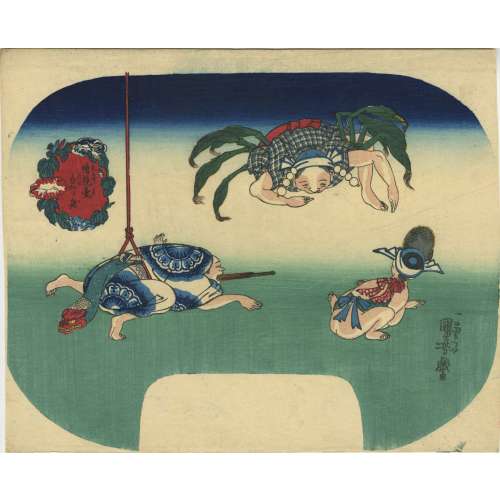 Artist: Utagawa Kuniyoshi [歌川 國芳] (Japanese, 1798 – 1861). Publisher: Ibaya Senzaburō [伊場屋仙三郎] (Japanese, c. 1815 – 1869), no publisher's seal on this print. Another title of this image provided by Sebastian Izzard is Acrobats becoming animals. The series Brother Pictures for Comparison [絵鏡台合かゝ身] (e-kyôdai awase kagami) can be found at Kuniyoshi Project: "This series consists of pairs of fan prints, with one print of each pair being a silhouette of the other. The series is not listed in Kuniyoshi by Basil William Robinson (Victoria and Albert Museum, London, 1961)". The series is attributed to c. 1840. Signed: Ichiyosai Kuniyoshi ga. Size: Size: Uchiwa-e (untrimmed fan print) 227 x 299 mm.
Artist: Utagawa Kuniyoshi [歌川 國芳] (Japanese, 1798 – 1861). Publisher: Ibaya Senzaburō [伊場屋仙三郎] (Japanese, c. 1815 – 1869), no publisher's seal on this print. Another title of this image provided by Sebastian Izzard is Acrobats becoming animals. The series Brother Pictures for Comparison [絵鏡台合かゝ身] (e-kyôdai awase kagami) can be found at Kuniyoshi Project: "This series consists of pairs of fan prints, with one print of each pair being a silhouette of the other. The series is not listed in Kuniyoshi by Basil William Robinson (Victoria and Albert Museum, London, 1961)". The series is attributed to c. 1840. Signed: Ichiyosai Kuniyoshi ga. Size: Size: Uchiwa-e (untrimmed fan print) 227 x 299 mm. -
![Adelbert von Chamisso. Peter Schlemihl's wundersame Geschichte. Nach des Dichters Tode neu herausgegeben von Julius Eduard Hitzig. Stereotypausgabe mit Holzschnitten. — Nürnberg: Johann Leonhard Schrag, [o.J.], [1839]. — XVI + 83 S.](https://varshavskycollection.com/wp-content/uploads/2021/02/LIB-1100.2016-b-scaled-500x500.jpeg) Title page (in Gothic script): Peter Schlemihl's | wundersame Geschichte | mitgetheilt | von | Adelbert von Chamisso. | {vignette} | Nach des Dichters Tode neu herausgegeben | von Julius Eduard Hitzig. | Stereotypausgabe mit Holzschnitten. | Nürnberg, | Johann Leonhard Schrag. || Pagination: [i-iii] iv-xvi, [1] 2-82 [2], 15 woodcut vignettes by Unzelmann after Menzel. Collation: 8vo; π8 1-58 62. Binding: 21.5 x 13.5 cm, blind olive wrappers. Year of publication inferred from the foreword. This is the first posthumous edition of Chamisso's novel. Personae: Chamisso, Adelbert von (German, 1781 – 1838). — Author of the text. Hitzig, Julius Eduard [Itzig, Isaac Elias] (German-Jewish, 1780 – 1849). — Author of the foreword. Menzel, Adolph Friedrich Erdmann von (German, 1815 – 1905). — Artist of the vignettes. Unzelmann, Friedrich Ludwig (German, 1797 – 1854). — Engraver of the woodcuts. Schrag, Johann Leonhard (Germany, 1783 – 1858). — Publisher.
Title page (in Gothic script): Peter Schlemihl's | wundersame Geschichte | mitgetheilt | von | Adelbert von Chamisso. | {vignette} | Nach des Dichters Tode neu herausgegeben | von Julius Eduard Hitzig. | Stereotypausgabe mit Holzschnitten. | Nürnberg, | Johann Leonhard Schrag. || Pagination: [i-iii] iv-xvi, [1] 2-82 [2], 15 woodcut vignettes by Unzelmann after Menzel. Collation: 8vo; π8 1-58 62. Binding: 21.5 x 13.5 cm, blind olive wrappers. Year of publication inferred from the foreword. This is the first posthumous edition of Chamisso's novel. Personae: Chamisso, Adelbert von (German, 1781 – 1838). — Author of the text. Hitzig, Julius Eduard [Itzig, Isaac Elias] (German-Jewish, 1780 – 1849). — Author of the foreword. Menzel, Adolph Friedrich Erdmann von (German, 1815 – 1905). — Artist of the vignettes. Unzelmann, Friedrich Ludwig (German, 1797 – 1854). — Engraver of the woodcuts. Schrag, Johann Leonhard (Germany, 1783 – 1858). — Publisher. -
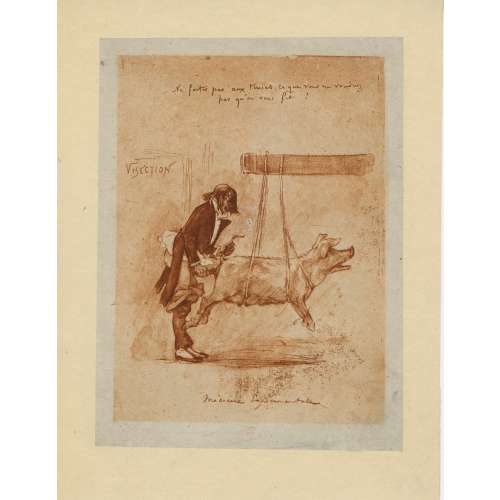
Sanguine print on toned China paper pasted on cream wove paper sheet, depicting a dressed-up man trying to copulate with a hanged sow. Inscription on top of the plate: "Ne faites pas aux truies ce que vous ne voudriez pas qu'on vous fit", and below: "Visection" (sic.). Owner's stamp 'LvM' on verso.
Dimensions: Paper: 26.8 x 20.6 cm; India paper: 21.5 x 16.2 cm; Image: 19.3 x 14.2 cm.
Catalogue raisonné: Arthur Hubschmid (1977): 661; Graphics irreverent and erotic (1968): 42.
-
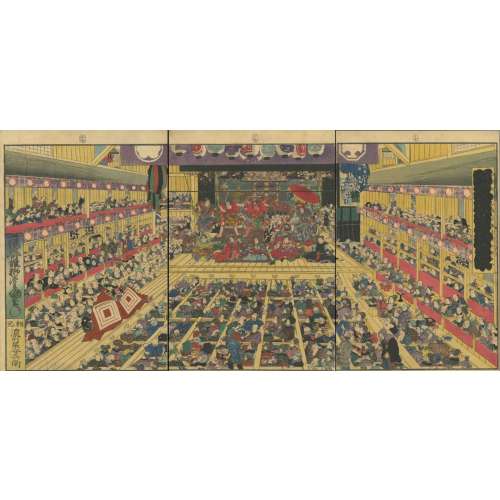 Superb Edo pictures illustrating dances (Odori keiyô Edo-e no sakae): Interior of an imaginary theatre with a performance of Shibaraku 「踊形容江戸絵栄」. Artist: Utagawa Kunisada [歌川 国貞] a.k.a. Utagawa Toyokuni III [三代歌川豊国] (Japanese, 1786 – 1865). Publisher: Nōshūya Yasubei (Japanese, fl. c. 1851 – 1870). Year: 1858 (Ansei 5), 7th month. Size: Vertical ôban triptych; 36.9 x 75.7 cm. Signed: 一陽斎雛獅豊国筆(年玉印) – Ichiyôsai Hinashi Toyokuni ga (on the left sheet only). Censor's seal: Horse 7 [午七 彫師]. Subject: Shibaraku. Ref.: MFA impression: 11.44263a-c; Robert Schaap. Kunisada (2016), p. 101 [LIB-1212.2017]. Ref.: [LIB-1197.2016] Arendie and Henk Herwig. Heroes of the Kabuki stage: an introduction to Kabuki with retellings of famous plays, illustrated by woodblock prints. — Amsterdam: Hotei Publishing, 2004; p. 38. [LIB-3316.2024] Chris Uhlenbeck, Jim Dwinger, Josephine Smit. The Riddles of Ukiyo-e: Women and Men in Japanese Prints. — Brussels: Ludion, 2023, p. 218-9, № 107.
Superb Edo pictures illustrating dances (Odori keiyô Edo-e no sakae): Interior of an imaginary theatre with a performance of Shibaraku 「踊形容江戸絵栄」. Artist: Utagawa Kunisada [歌川 国貞] a.k.a. Utagawa Toyokuni III [三代歌川豊国] (Japanese, 1786 – 1865). Publisher: Nōshūya Yasubei (Japanese, fl. c. 1851 – 1870). Year: 1858 (Ansei 5), 7th month. Size: Vertical ôban triptych; 36.9 x 75.7 cm. Signed: 一陽斎雛獅豊国筆(年玉印) – Ichiyôsai Hinashi Toyokuni ga (on the left sheet only). Censor's seal: Horse 7 [午七 彫師]. Subject: Shibaraku. Ref.: MFA impression: 11.44263a-c; Robert Schaap. Kunisada (2016), p. 101 [LIB-1212.2017]. Ref.: [LIB-1197.2016] Arendie and Henk Herwig. Heroes of the Kabuki stage: an introduction to Kabuki with retellings of famous plays, illustrated by woodblock prints. — Amsterdam: Hotei Publishing, 2004; p. 38. [LIB-3316.2024] Chris Uhlenbeck, Jim Dwinger, Josephine Smit. The Riddles of Ukiyo-e: Women and Men in Japanese Prints. — Brussels: Ludion, 2023, p. 218-9, № 107. -
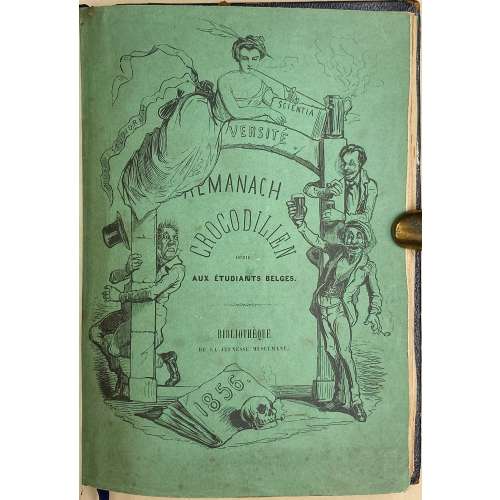 One volume collated 8vo, 19 x 14 cm, bound in black alligator leather. Front wrapper (green) / title-page (white): A female figure smoking a pipe next to a beer mug, reclining over an arch ring lettered “…VERSITÉ” (UNI… not shown), her dress ribbon lettered “MUSA STUDIORUM”, holding a book lettered “SCIENTIA”; within the arch « ALMANACH | CROCODILIEN | DÉDIÉ | AUX ÉTUDIANTS BELGES. | BIBLIOTHÈQUE | DE LA JEUNESSE MUSULMANE. »; below lies a book lettered “1856.”, next to it is a smoking skull; three male figures embracing the arch columns. Half-title: ALMANACH CROCODILIEN | POUR | L’ANNÉE BISSEXTILE, MAIS NÉANMOINS DE GRACE | 1856. || Pagination: [1-5] 6-14 [15-41] 42-134 [137] 138, total 136 pages within the wrappers, original publisher's green wrappers preserved, carte de visite ‘Félicien Rops, Étudiant’ and pink invitation card № 129 for ‘Bal des femmes’ on March 19, 1892 at ‘Fête annuelle du Courier Français’ bound in; in-text woodcuts, initials, head- and tail-pieces after Félicien Rops. Bookplate “Ex Libris Marcellus Schlimovich” with motto “Ars naturam adiuvat” on front pastedown. Stamp of the "Sociedad Hebraica Argentina / Coleccion M. Schlimovich / Varios / No. 2-492” to half-title. Pencil inscription to half-title: "Ex. Félicien Rops" – possibly an own copy of the artist. Collation: π2 1-88 92, total 68 leaves within wrappers. Printer: Typ. de J. Vanbuggenhoudt (Bruxelles). Sociedad Hebraica Argentina; Marcelo Schlimovich (Argentine-Jewish, ca. 1880 – 1960) – provenance. Félicien Rops (Belgian, 1833 – 1898) – artist.
One volume collated 8vo, 19 x 14 cm, bound in black alligator leather. Front wrapper (green) / title-page (white): A female figure smoking a pipe next to a beer mug, reclining over an arch ring lettered “…VERSITÉ” (UNI… not shown), her dress ribbon lettered “MUSA STUDIORUM”, holding a book lettered “SCIENTIA”; within the arch « ALMANACH | CROCODILIEN | DÉDIÉ | AUX ÉTUDIANTS BELGES. | BIBLIOTHÈQUE | DE LA JEUNESSE MUSULMANE. »; below lies a book lettered “1856.”, next to it is a smoking skull; three male figures embracing the arch columns. Half-title: ALMANACH CROCODILIEN | POUR | L’ANNÉE BISSEXTILE, MAIS NÉANMOINS DE GRACE | 1856. || Pagination: [1-5] 6-14 [15-41] 42-134 [137] 138, total 136 pages within the wrappers, original publisher's green wrappers preserved, carte de visite ‘Félicien Rops, Étudiant’ and pink invitation card № 129 for ‘Bal des femmes’ on March 19, 1892 at ‘Fête annuelle du Courier Français’ bound in; in-text woodcuts, initials, head- and tail-pieces after Félicien Rops. Bookplate “Ex Libris Marcellus Schlimovich” with motto “Ars naturam adiuvat” on front pastedown. Stamp of the "Sociedad Hebraica Argentina / Coleccion M. Schlimovich / Varios / No. 2-492” to half-title. Pencil inscription to half-title: "Ex. Félicien Rops" – possibly an own copy of the artist. Collation: π2 1-88 92, total 68 leaves within wrappers. Printer: Typ. de J. Vanbuggenhoudt (Bruxelles). Sociedad Hebraica Argentina; Marcelo Schlimovich (Argentine-Jewish, ca. 1880 – 1960) – provenance. Félicien Rops (Belgian, 1833 – 1898) – artist. -
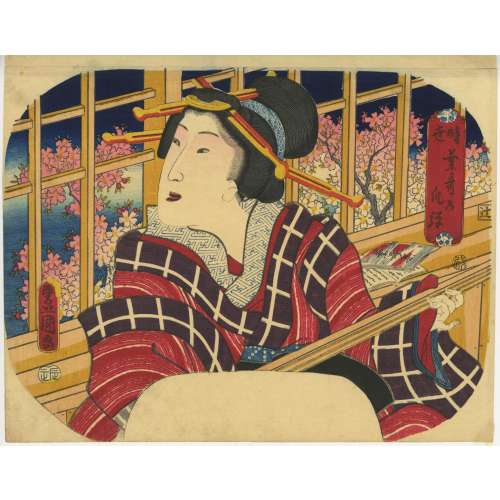 Artist: Utagawa Kunisada [歌川 国貞], a.k.a. Utagawa Toyokuni III [三代 歌川 豊国] (Japanese, 1786 – 1865). Signed: Toyokuni ga [豊国 画] in a red toshidama cartouche Publisher: Iseya Ichiemon [伊勢屋市右衛門] (Japanese, fl. c. 1820s – c. 1860s); seal Tsuji [辻] (Marks 16-029). Media: Untrimmed fan print (uchiwa-e), 225 x 295 mm, plus 10 mm paper strip glued on top (235 mm total height). Title: Plucking Popular Songs in Those Days [時世葉歌の爪弾] (Imayo ha-uta no tsuma-biki). Date seal and aratame seal: Ansei 3 (1856). Seller's Description: Uchiwa-e; picture intended for a summer fan. Here we see a relaxed beauty wearing loose layers of kimono and playing her shamisen instrument. She appears to be in the happy mood of spring, her singing inspired by the cherry blossoms in full bloom that we see outside of her window. She enjoys leisurely plucking with the plectrum of the shamisen and singing “ha-uta” (popular) songs. The title Ha-uta [葉歌] is normally written 端歌, which indicates a certain category of popular songs accompanied by shamisen with short texts that are drawn from daily life. Here however, the title葉歌 uses phonetically the same “ha葉“, referring to the title of the book of a collection of ha-uta songs, Matsu no ha [松の], which was published in five volumes in 1703 by Shûshôken 秀松軒. It is said that this collection of songs was written and sung by the blind (who were often musicians by livelihood). Behind her, lying on the window sill, we see two ha-uta songbooks, one open and one closed. The last half of the title tsuma-biki [爪弾] translates “to pluck with fingers” instead of a plectrum, which is the usual way of playing the shamisen.
Artist: Utagawa Kunisada [歌川 国貞], a.k.a. Utagawa Toyokuni III [三代 歌川 豊国] (Japanese, 1786 – 1865). Signed: Toyokuni ga [豊国 画] in a red toshidama cartouche Publisher: Iseya Ichiemon [伊勢屋市右衛門] (Japanese, fl. c. 1820s – c. 1860s); seal Tsuji [辻] (Marks 16-029). Media: Untrimmed fan print (uchiwa-e), 225 x 295 mm, plus 10 mm paper strip glued on top (235 mm total height). Title: Plucking Popular Songs in Those Days [時世葉歌の爪弾] (Imayo ha-uta no tsuma-biki). Date seal and aratame seal: Ansei 3 (1856). Seller's Description: Uchiwa-e; picture intended for a summer fan. Here we see a relaxed beauty wearing loose layers of kimono and playing her shamisen instrument. She appears to be in the happy mood of spring, her singing inspired by the cherry blossoms in full bloom that we see outside of her window. She enjoys leisurely plucking with the plectrum of the shamisen and singing “ha-uta” (popular) songs. The title Ha-uta [葉歌] is normally written 端歌, which indicates a certain category of popular songs accompanied by shamisen with short texts that are drawn from daily life. Here however, the title葉歌 uses phonetically the same “ha葉“, referring to the title of the book of a collection of ha-uta songs, Matsu no ha [松の], which was published in five volumes in 1703 by Shûshôken 秀松軒. It is said that this collection of songs was written and sung by the blind (who were often musicians by livelihood). Behind her, lying on the window sill, we see two ha-uta songbooks, one open and one closed. The last half of the title tsuma-biki [爪弾] translates “to pluck with fingers” instead of a plectrum, which is the usual way of playing the shamisen. -
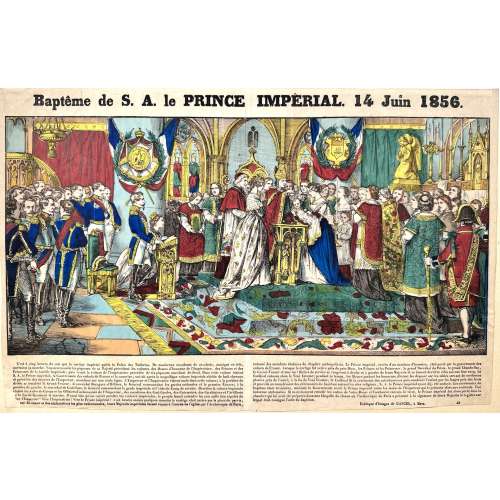 Hand-coloured woodcut on wove paper, 610 x 390 mm; black ink stamp “5207” to reverse, attached to a larger sheet of thick paper with a red ink stamp: “COLLECTION JEAN-CLAUD LACHNITT | REPRODUCTION INTERDIT”. Top: Baptême de S. A. le PRINCE IMPÉRIAL. 14 Juin 1856; image of baptism of Prince-Impérial; two-column text with a small loss in the lower left corner (C'est à cinq heures du soir que le cortège impérial quitta le Palais des Tuileries. De nombreux escadrons de cavalerie, musique en tête ouvraient la marche. ...); bottom under the text: "Fabrique d'Images de GANGEL, à Metz." — "49".
Hand-coloured woodcut on wove paper, 610 x 390 mm; black ink stamp “5207” to reverse, attached to a larger sheet of thick paper with a red ink stamp: “COLLECTION JEAN-CLAUD LACHNITT | REPRODUCTION INTERDIT”. Top: Baptême de S. A. le PRINCE IMPÉRIAL. 14 Juin 1856; image of baptism of Prince-Impérial; two-column text with a small loss in the lower left corner (C'est à cinq heures du soir que le cortège impérial quitta le Palais des Tuileries. De nombreux escadrons de cavalerie, musique en tête ouvraient la marche. ...); bottom under the text: "Fabrique d'Images de GANGEL, à Metz." — "49". -
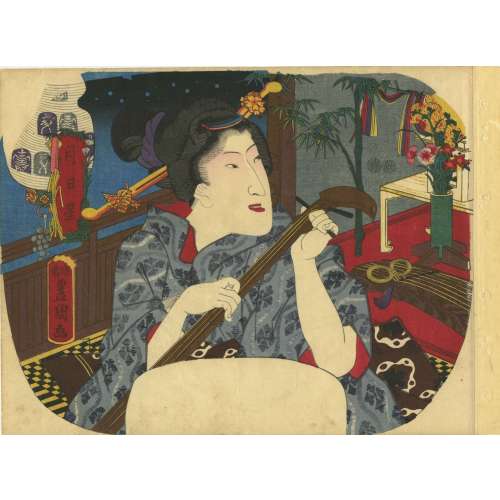 Artist: Utagawa Kunisada [歌川 国貞] a.k.a. Utagawa Toyokuni III [三代歌川豊国] (Japanese, 1786 – 1865). Signed: Ōju Toyokuni ga [応需豊国画], in a toshidama cartouche. Double nanushi censor seals: Mera & Murata (1846-50). Publisher: Kojimaya Jūbei [小嶋屋重兵衛] (Japanese, fl. c. 1797 – 1869). A beautiful woman, possibly a kabuki actor Iwai Hanshirō VIII [岩井半四郎] (Iwai Shijaku II, Iwai Kumesaburō III [岩井粂三郎], Iwai Hisajirō II, Japanese, 1829 – 1882), tuning the samisen on a veranda under the shining stars. The complete set of series Moon, Sun, Stars [月日星] (tsuki-hi-hoshi/boshi), three sources of light (sankō) [三光]:
Artist: Utagawa Kunisada [歌川 国貞] a.k.a. Utagawa Toyokuni III [三代歌川豊国] (Japanese, 1786 – 1865). Signed: Ōju Toyokuni ga [応需豊国画], in a toshidama cartouche. Double nanushi censor seals: Mera & Murata (1846-50). Publisher: Kojimaya Jūbei [小嶋屋重兵衛] (Japanese, fl. c. 1797 – 1869). A beautiful woman, possibly a kabuki actor Iwai Hanshirō VIII [岩井半四郎] (Iwai Shijaku II, Iwai Kumesaburō III [岩井粂三郎], Iwai Hisajirō II, Japanese, 1829 – 1882), tuning the samisen on a veranda under the shining stars. The complete set of series Moon, Sun, Stars [月日星] (tsuki-hi-hoshi/boshi), three sources of light (sankō) [三光]: -
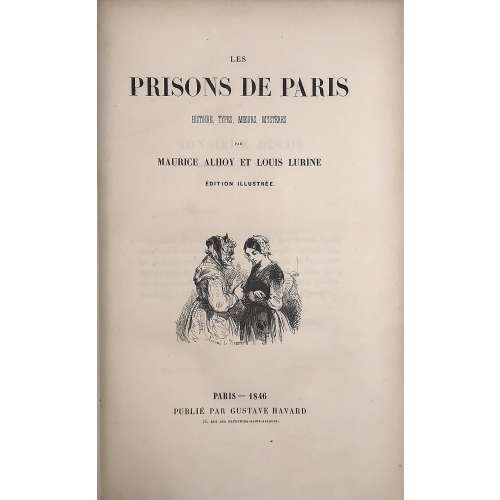 Exterior: 4to, 27.3 x 18 cm, quarter black morocco over marbled boards, double gilt fillet border, spine with raised bands, compartments framed in gilt with gilt fleurons, black label lettered in gilt; marbled endpapers. Inscription to half-title in the bottom: no 411. Bookplate to front pastedown. Title-page: LES | PRISONS DE PARIS | HISTOIRE, TYPES, MŒURS, MYSTÈRES | PAR | MAURICE ALHOY ET LOUIS LURINE | ÉDITION ILLUSTRÉE. | {vignette} | PARIS — 1846 | PUBLIÉ PAR GUSTAVE HAVARD | 24, RUE DES MATHURINS-SAINT-JACQUES. || Printer: Lacrampe et Comp. Collation: 4to; π2 a4 1-684 χ2; total 280 leaves and 34 leaves of plates. Pagination: first and last leaves blank; [2 -h.t./imprint.] [2 - t.p./blank] [2 dedication/blank] [i intro] ii-vi, [1] 2-544 [2 - list of plates/advert.] [2 - contents/blank]; total 560 pages, plus 34 wood-engraved plates, incl. a frontispiece by Laisne after Bertall, and numerous in-text woodcuts. Provenance: Bookplate of Selim Hippolyte Ansart (French, 1829 – 1897), commissar of police in the Second Empire and shortly after (chef de la police municipaie ; chevalier du 13 août 1867; vingt-trois ans de service effectif). Authors: Philadelphe-Maurice Alhoy (French, 1802 – 1856) Louis Lurine (French, 1812 – 1860) Artists: Bertall [ Bertal; Charles Albert d’Arnoux (French, 1820 – 1882) Jules [Jean-Baptiste] David (French, 1808–1892) Charles-François Pinot (French, 1817 – 1879) Eustache Lorsay [French, Eugène Lampsonius] (1822 – 1871) Pierre Édouard Frère (French, 1819 – 1886) Charles-Édouard de Beaumont (French, 1819 – 1888) Engravers Laisné Adèle / Aglaé / Alfred (French, fl. 1835 – 1868) Louis Dujardin (French, 1808 – 1859) François Rouget (Belgian, c. 1825 – ?) Janet-Lange [Ange-Louis Janet] (French, 1815 – 1872) Jacques Adrien Lavieille (French, 1818 – 1862) Timms (French, fl. c. 1839 – 1865) Félix Leblanc (French, 1823 – ?) Émile Montigneul (French, fl. 1840 – 1850)
Exterior: 4to, 27.3 x 18 cm, quarter black morocco over marbled boards, double gilt fillet border, spine with raised bands, compartments framed in gilt with gilt fleurons, black label lettered in gilt; marbled endpapers. Inscription to half-title in the bottom: no 411. Bookplate to front pastedown. Title-page: LES | PRISONS DE PARIS | HISTOIRE, TYPES, MŒURS, MYSTÈRES | PAR | MAURICE ALHOY ET LOUIS LURINE | ÉDITION ILLUSTRÉE. | {vignette} | PARIS — 1846 | PUBLIÉ PAR GUSTAVE HAVARD | 24, RUE DES MATHURINS-SAINT-JACQUES. || Printer: Lacrampe et Comp. Collation: 4to; π2 a4 1-684 χ2; total 280 leaves and 34 leaves of plates. Pagination: first and last leaves blank; [2 -h.t./imprint.] [2 - t.p./blank] [2 dedication/blank] [i intro] ii-vi, [1] 2-544 [2 - list of plates/advert.] [2 - contents/blank]; total 560 pages, plus 34 wood-engraved plates, incl. a frontispiece by Laisne after Bertall, and numerous in-text woodcuts. Provenance: Bookplate of Selim Hippolyte Ansart (French, 1829 – 1897), commissar of police in the Second Empire and shortly after (chef de la police municipaie ; chevalier du 13 août 1867; vingt-trois ans de service effectif). Authors: Philadelphe-Maurice Alhoy (French, 1802 – 1856) Louis Lurine (French, 1812 – 1860) Artists: Bertall [ Bertal; Charles Albert d’Arnoux (French, 1820 – 1882) Jules [Jean-Baptiste] David (French, 1808–1892) Charles-François Pinot (French, 1817 – 1879) Eustache Lorsay [French, Eugène Lampsonius] (1822 – 1871) Pierre Édouard Frère (French, 1819 – 1886) Charles-Édouard de Beaumont (French, 1819 – 1888) Engravers Laisné Adèle / Aglaé / Alfred (French, fl. 1835 – 1868) Louis Dujardin (French, 1808 – 1859) François Rouget (Belgian, c. 1825 – ?) Janet-Lange [Ange-Louis Janet] (French, 1815 – 1872) Jacques Adrien Lavieille (French, 1818 – 1862) Timms (French, fl. c. 1839 – 1865) Félix Leblanc (French, 1823 – ?) Émile Montigneul (French, fl. 1840 – 1850) -
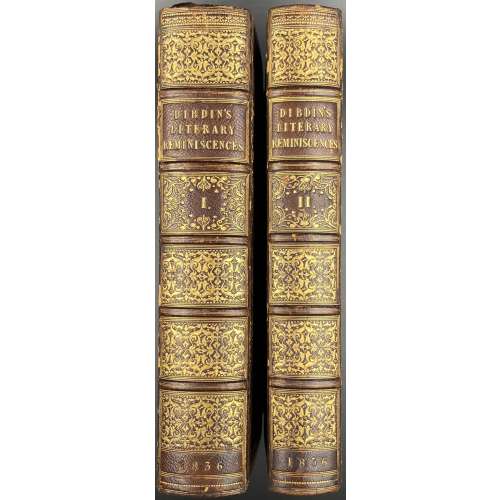 Two volumes uniformly bound by J. Mackenzie, in brown straight-grain morocco, boards with 7 gilt fillet border, fleuron corners, spine with raised bands, gilt in compartments, gilt-lettered DIBDIN’S | LITERARY | REMINISCENCES | I (or) II | 1836. All margins gilt, cream endpapers, armorial bookplate of William Henry Rossington to the front pastedown. Vol. 1: Title page: REMINISCENCES | OF | A LITERARY LIFE; | BY THE REVEREND | THOS. FROGNALL DIBDIN, D.D. | {vignette} | {one line citation | Richard de Bury} | LONDON: | JOHN MAJOR, 71, GREAT RUSSELL-STREET, | BLOOMSBURY. | MDCCCXXXVI. || Pagination: [4] two blank leaves, [i-v] vi-xxxii [4] list of plates, corrections, [1] 2-556 [4] two blank leaves. Collation: 8vo; [a]8 b8 [c]2, B-Z8, AA-MM8 NN6, 5 plates (incl. frontis. portrait by James Posselwhite after George Richmond) extraneous to collation, and a few vignettes in text. Vol. 2: Title page: REMINISCENCES | OF | A LITERARY LIFE; | WITH ANECDOTES OF BOOKS, | AND OF | BOOK COLLECTORS: | BY THE REVEREND | THOS. FROGNALL DIBDIN, D.D. | PART THE SECOND. | LONDON: | JOHN MAJOR, 71, GREAT RUSSELL-STREET, | BLOOMSBURY. | MDCCCXXXVI. || Pagination: [4] two blank leaves, [2] title/blank, 557-982, [1-3] 4-44 index, [4] two blank leaves. Collation: 8vo; [NN]2 OO-ZZ8 3A-3Q8 3R3, B-C8 D4, 5 plates (incl. frontis. “The Library, Eshton Hall”) extraneous to collation, and a few vignettes in text. Catalogue raisonné: Windle, Pippin (1999): A62 / pp. 171-177. Contributors: Author: Thomas Frognall Dibdin (British, 1776 – 1847) Artists: George Richmond (British, 1809 – 1896); Mary Dawson Turner [neé Mary Palgrave] (British, 1774 – 1850); Frederick Mackenzie (British, 1788? – 1854); C. J. Stewart (British, fl. 1830s). Copper engravers: James Posselwhite (British, 1798-1884); Philip Audinet (British, 1766 – 1837); William Henry Worthington. (British, c. 1790 – after 1839); Samuel Rawle (British, 1771 – 1860); Samuel Freeman (British, 1773 – 1857); James Thomson (British, 1788–1850). Wood engravings by John Byfield (British, 1788-1841) and his sister Mary Byfield (British, 1795 – 1871). Printer: William Wilcockson, Rolls Buildings, Fetter Lane. Publisher: John Major (British, 1782 – 1849) Binder: John Mackenzie (British, 1788 – c.1850) – held the office of bookbinder to both King George IV and King William IV. Bookplate: Colonel William Henry Rossington (American, 1848 – 1908)
Two volumes uniformly bound by J. Mackenzie, in brown straight-grain morocco, boards with 7 gilt fillet border, fleuron corners, spine with raised bands, gilt in compartments, gilt-lettered DIBDIN’S | LITERARY | REMINISCENCES | I (or) II | 1836. All margins gilt, cream endpapers, armorial bookplate of William Henry Rossington to the front pastedown. Vol. 1: Title page: REMINISCENCES | OF | A LITERARY LIFE; | BY THE REVEREND | THOS. FROGNALL DIBDIN, D.D. | {vignette} | {one line citation | Richard de Bury} | LONDON: | JOHN MAJOR, 71, GREAT RUSSELL-STREET, | BLOOMSBURY. | MDCCCXXXVI. || Pagination: [4] two blank leaves, [i-v] vi-xxxii [4] list of plates, corrections, [1] 2-556 [4] two blank leaves. Collation: 8vo; [a]8 b8 [c]2, B-Z8, AA-MM8 NN6, 5 plates (incl. frontis. portrait by James Posselwhite after George Richmond) extraneous to collation, and a few vignettes in text. Vol. 2: Title page: REMINISCENCES | OF | A LITERARY LIFE; | WITH ANECDOTES OF BOOKS, | AND OF | BOOK COLLECTORS: | BY THE REVEREND | THOS. FROGNALL DIBDIN, D.D. | PART THE SECOND. | LONDON: | JOHN MAJOR, 71, GREAT RUSSELL-STREET, | BLOOMSBURY. | MDCCCXXXVI. || Pagination: [4] two blank leaves, [2] title/blank, 557-982, [1-3] 4-44 index, [4] two blank leaves. Collation: 8vo; [NN]2 OO-ZZ8 3A-3Q8 3R3, B-C8 D4, 5 plates (incl. frontis. “The Library, Eshton Hall”) extraneous to collation, and a few vignettes in text. Catalogue raisonné: Windle, Pippin (1999): A62 / pp. 171-177. Contributors: Author: Thomas Frognall Dibdin (British, 1776 – 1847) Artists: George Richmond (British, 1809 – 1896); Mary Dawson Turner [neé Mary Palgrave] (British, 1774 – 1850); Frederick Mackenzie (British, 1788? – 1854); C. J. Stewart (British, fl. 1830s). Copper engravers: James Posselwhite (British, 1798-1884); Philip Audinet (British, 1766 – 1837); William Henry Worthington. (British, c. 1790 – after 1839); Samuel Rawle (British, 1771 – 1860); Samuel Freeman (British, 1773 – 1857); James Thomson (British, 1788–1850). Wood engravings by John Byfield (British, 1788-1841) and his sister Mary Byfield (British, 1795 – 1871). Printer: William Wilcockson, Rolls Buildings, Fetter Lane. Publisher: John Major (British, 1782 – 1849) Binder: John Mackenzie (British, 1788 – c.1850) – held the office of bookbinder to both King George IV and King William IV. Bookplate: Colonel William Henry Rossington (American, 1848 – 1908) -
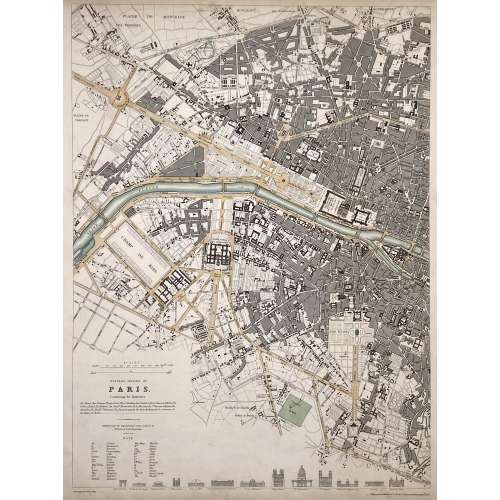 WESTERN DIVISION OF | PARIS. | Containing the Quartiers | {4 lines in italic} | Published under the Superintendence of the Society for the | Diffusion of Useful Knowledge || Under the frame: Drawn by W. B. Clarke, Archt. […] Published by Baldwin & Cradock, 47 Paternoster Row, April 1st. 1834. Dimensions: Sheet: 40.5 x 34.5 cm; Image: 39 x 28.8 cm. Contributors: William Barnard Clarke (British, 1806 – 1865) – artist. John Shury (fl. c. 1814-1844) – engraver. Baldwin & Cradock (London) – publisher. Society for the Diffusion of Useful Knowledge (SDUK) (British firm, 1826 – 1846).
WESTERN DIVISION OF | PARIS. | Containing the Quartiers | {4 lines in italic} | Published under the Superintendence of the Society for the | Diffusion of Useful Knowledge || Under the frame: Drawn by W. B. Clarke, Archt. […] Published by Baldwin & Cradock, 47 Paternoster Row, April 1st. 1834. Dimensions: Sheet: 40.5 x 34.5 cm; Image: 39 x 28.8 cm. Contributors: William Barnard Clarke (British, 1806 – 1865) – artist. John Shury (fl. c. 1814-1844) – engraver. Baldwin & Cradock (London) – publisher. Society for the Diffusion of Useful Knowledge (SDUK) (British firm, 1826 – 1846). -
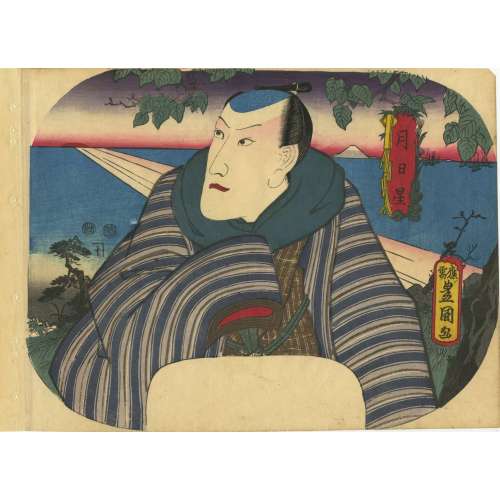 Artist: Utagawa Kunisada [歌川 国貞] a.k.a. Utagawa Toyokuni III [三代歌川豊国] (Japanese, 1786 – 1865). Signed: Ōju Toyokuni ga [応需豊国画], in a toshidama cartouche. Double nanushi censor seals Mera & Murata (1846-50). Publisher: Kojimaya Jūbei [小嶋屋重兵衛] (Japanese, fl. c. 1797 – 1869). Kabuki actor Ichikawa Danjūrō VIII [市川団十郎] (Ichikawa Ebizō VI, Ichikawa Shinnosuke II, Japanese, 1823 – 1854) watches the sunrise over Mount Fuji. The complete set of series Moon, Sun, Stars [月日星] (tsuki-hi-hoshi/boshi), three sources of light (sankō) [三光]:
Artist: Utagawa Kunisada [歌川 国貞] a.k.a. Utagawa Toyokuni III [三代歌川豊国] (Japanese, 1786 – 1865). Signed: Ōju Toyokuni ga [応需豊国画], in a toshidama cartouche. Double nanushi censor seals Mera & Murata (1846-50). Publisher: Kojimaya Jūbei [小嶋屋重兵衛] (Japanese, fl. c. 1797 – 1869). Kabuki actor Ichikawa Danjūrō VIII [市川団十郎] (Ichikawa Ebizō VI, Ichikawa Shinnosuke II, Japanese, 1823 – 1854) watches the sunrise over Mount Fuji. The complete set of series Moon, Sun, Stars [月日星] (tsuki-hi-hoshi/boshi), three sources of light (sankō) [三光]: -
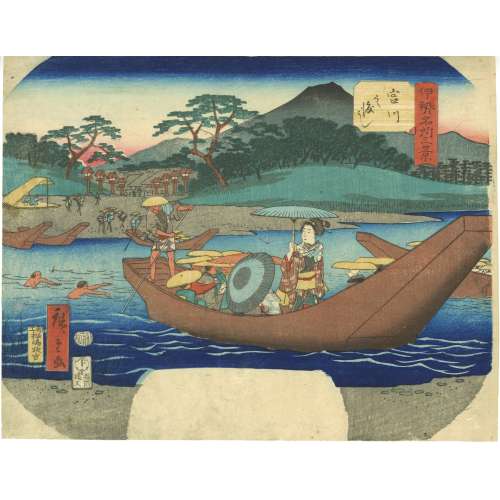 Artist: Utagawa Hiroshige II (二代目 歌川広重] (Japanese, 1826 – 1869). Signed: Hiroshige ga. Publisher: Enshūya Matabei [遠州屋又兵衛] (Japanese, fl. c. 1768 – 1881); (Enmata [遠又]), seal 22-009 (Marks). Block carver: Matsushima Masakichi (Japanese, fl. c. 1847-65); seal: [松嶋彫政] – Hori Masa (Frieze, 2009: 142). Combined date seal and kiwame censor seal: Bunkyū 2 (1862). Media: Fan print (uchiwa-e, 団扇絵), 230 x 298 mm Series: Three Famous Views in Ise [伊勢名所三景] (Ise meisho sankei).
Artist: Utagawa Hiroshige II (二代目 歌川広重] (Japanese, 1826 – 1869). Signed: Hiroshige ga. Publisher: Enshūya Matabei [遠州屋又兵衛] (Japanese, fl. c. 1768 – 1881); (Enmata [遠又]), seal 22-009 (Marks). Block carver: Matsushima Masakichi (Japanese, fl. c. 1847-65); seal: [松嶋彫政] – Hori Masa (Frieze, 2009: 142). Combined date seal and kiwame censor seal: Bunkyū 2 (1862). Media: Fan print (uchiwa-e, 団扇絵), 230 x 298 mm Series: Three Famous Views in Ise [伊勢名所三景] (Ise meisho sankei). -
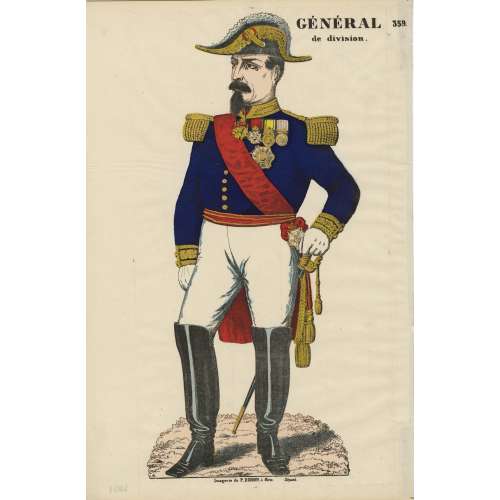 Hand-coloured woodcut on wove paper, 430 x 285 mm; black ink stamp “5051” to reverse. Top right: "GÉNÉRAL | de division." — "359." Bottom: "Imagerie de DIDION, à Metz. Déposé." Paulin Didion (French, 1831 – 1879) – publisher/printer.
Hand-coloured woodcut on wove paper, 430 x 285 mm; black ink stamp “5051” to reverse. Top right: "GÉNÉRAL | de division." — "359." Bottom: "Imagerie de DIDION, à Metz. Déposé." Paulin Didion (French, 1831 – 1879) – publisher/printer. -
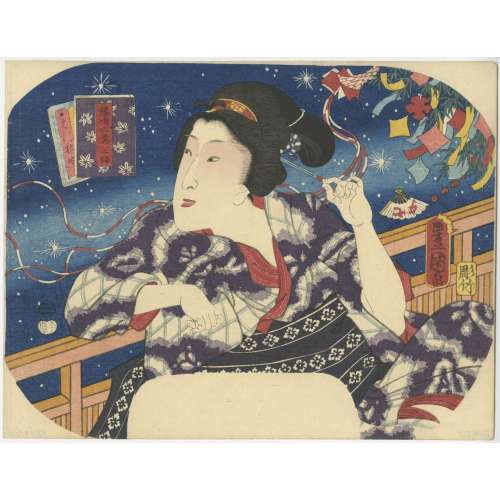 Artist: Utagawa Kunisada [歌川 国貞], a.k.a. Utagawa Toyokuni III [三代 歌川 豊国] (Japanese, 1786 – 1865). Signed: Toyokuni ga [豊国 画] in a red toshidama cartouche Block carver: Yokokawa Takejirō [横川竹二郎] (Japanese, fl. 1845 – 1863), seal: 彫竹 – Hori Take. Publisher: Ibaya Senzaburō [伊場屋仙三郎] (Japanese, fl. c. 1845 – 1847). Combined date and kiwame seal: Ansei 5 (II-XII/1858). Size: Untrimmed fan print (uchiwa-e), 300 x 232 mm.
Artist: Utagawa Kunisada [歌川 国貞], a.k.a. Utagawa Toyokuni III [三代 歌川 豊国] (Japanese, 1786 – 1865). Signed: Toyokuni ga [豊国 画] in a red toshidama cartouche Block carver: Yokokawa Takejirō [横川竹二郎] (Japanese, fl. 1845 – 1863), seal: 彫竹 – Hori Take. Publisher: Ibaya Senzaburō [伊場屋仙三郎] (Japanese, fl. c. 1845 – 1847). Combined date and kiwame seal: Ansei 5 (II-XII/1858). Size: Untrimmed fan print (uchiwa-e), 300 x 232 mm.A young woman adjusting her hairpin on a balcony during the Tanabata festival, as inscribed on the white folding fan: [七夕] (Tanabata).
Inscription on the blue book (print title): Early autumn [はつ秋や] (hatsu akiya), inscription on the purple book (series title): Short love songs, second volume [端唄の意 二編] (Hauta no kokoro nihen). According to Marks (2010), Hauta no kokoro nihen series of fan prints was published by Ibaya in 1858 (p. 267|P6871).
The series refers to love songs of a certain type popular in late Edo. They were performed with the accompaniment of a shamisen, “Seven herbs of autumn, the song of the insects is not heard; the bodies of lightning bugs are burnt, and the precious writings of love are getting thinner like the song of the insects as I am waiting for you. So, on an early autumn evening, I spot the glitter of a lightning bug that lingered among the autumn grasses, and while listening to the pine cricket, I am singing with my heart troubled by love". [Tokyo National Museum; translation provided by Elena Varshavsky].Tanabata [たなばた] or [七夕] – meaning "Evening of the seventh", also known as the Star Festival [星祭] (Hoshi matsuri) – is a Japanese festival originating from the Chinese Qixi Festival. One popular Tanabata custom is to write one's wishes on a piece of paper and hang that piece of paper on a specially erected bamboo tree, in the hope that the wishes become true.
-
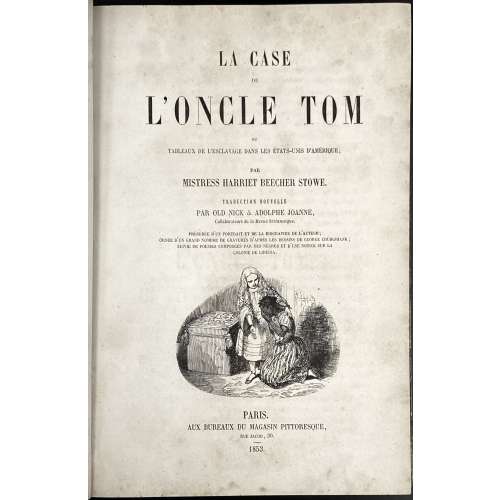 1st French edition (Paris, 1853) of Harriet Beecher Stowe's book Uncle Tom's Cabin; or, Life Among the Lowly, with 27 illustrations on wood by George Cruikshank (British, 1792 – 1878), translated into French by Paul-Émile Daurand-Forgues [pseudonym Old Nick] (French, 1813 – 1883) and Adolphe Joanne (French, 1813 – 1881). Title: LA CASE | DE | L'ONCLE TOM | OU | TABLE AUX DE L'ESCLAVAGE DANS LES ÉTATS-UNIS D'AMÉRIQUE ; | PAR MISTRESS HARRIET BEECHER STOWE. | TRADUCTION NOUVELLE | PAR OLD NICK & ADOLPHE JOANNE, | Collaboarteurs de la Revue britannique, | PRÉCÉDÉE D'UN PORTRAIT ET DE LA BIOGRAPHIE DE L'AUTEUR; | ORNÉE D'IU GRAND NOMBRE DE GRAVURES D'APRES LES DESSINS DE GEORGE CRUIKSHANK ; | SUIVIE DE POÉSIES COMPOSÉES PAR DES NÈGRES ET D'UNE NOTICE SUR LA | COLONIE DE LIBERIA. | [vignette] | PARIS. | AUX BUREAUX DU MAGASIN PITTORESQUE, | RUE JACOB, 30. | 1853. Pagination: ffl blank; [i-ii]: h.t. with stamped letters D. W. in the upper centre / imprim. to verso; [iii-iv] t.p. / blank; [v-vi] blank / frontispiece: portrait of Harriet Beecher Stowe, half-length to left, with hair in ringlets, and a shawl over shoulders, landscape behind, Henry Linton (British, 1815 – 1899) after Henry Anelay (British,1817 – 1883), wood-engraving with letterpress; [vij] Viij-xij; [1] 2-563 [564]; bfl blank; illustrations: 27 woodcuts by George Cruikshank. Collation: 8vo, π7 (1)–(35)8 363 Binding: Quarter brown calf, spine with raised bands, gilt-ruled compartments, title lettering, "D. W." in the bottom, marbled boards and endpapers. Dimensions: 24.1 x 16.4 cm. Catalogue raisonné: Albert M. Cohen (1924), №777, p. 221. "An edition was published in French with the woodcuts direct from the blocks, not, as in the English, merely from the stereotypes. The illustrations are far more impressive than those of Cassell's edition".
1st French edition (Paris, 1853) of Harriet Beecher Stowe's book Uncle Tom's Cabin; or, Life Among the Lowly, with 27 illustrations on wood by George Cruikshank (British, 1792 – 1878), translated into French by Paul-Émile Daurand-Forgues [pseudonym Old Nick] (French, 1813 – 1883) and Adolphe Joanne (French, 1813 – 1881). Title: LA CASE | DE | L'ONCLE TOM | OU | TABLE AUX DE L'ESCLAVAGE DANS LES ÉTATS-UNIS D'AMÉRIQUE ; | PAR MISTRESS HARRIET BEECHER STOWE. | TRADUCTION NOUVELLE | PAR OLD NICK & ADOLPHE JOANNE, | Collaboarteurs de la Revue britannique, | PRÉCÉDÉE D'UN PORTRAIT ET DE LA BIOGRAPHIE DE L'AUTEUR; | ORNÉE D'IU GRAND NOMBRE DE GRAVURES D'APRES LES DESSINS DE GEORGE CRUIKSHANK ; | SUIVIE DE POÉSIES COMPOSÉES PAR DES NÈGRES ET D'UNE NOTICE SUR LA | COLONIE DE LIBERIA. | [vignette] | PARIS. | AUX BUREAUX DU MAGASIN PITTORESQUE, | RUE JACOB, 30. | 1853. Pagination: ffl blank; [i-ii]: h.t. with stamped letters D. W. in the upper centre / imprim. to verso; [iii-iv] t.p. / blank; [v-vi] blank / frontispiece: portrait of Harriet Beecher Stowe, half-length to left, with hair in ringlets, and a shawl over shoulders, landscape behind, Henry Linton (British, 1815 – 1899) after Henry Anelay (British,1817 – 1883), wood-engraving with letterpress; [vij] Viij-xij; [1] 2-563 [564]; bfl blank; illustrations: 27 woodcuts by George Cruikshank. Collation: 8vo, π7 (1)–(35)8 363 Binding: Quarter brown calf, spine with raised bands, gilt-ruled compartments, title lettering, "D. W." in the bottom, marbled boards and endpapers. Dimensions: 24.1 x 16.4 cm. Catalogue raisonné: Albert M. Cohen (1924), №777, p. 221. "An edition was published in French with the woodcuts direct from the blocks, not, as in the English, merely from the stereotypes. The illustrations are far more impressive than those of Cassell's edition".



